When you are thinking about the greatest brand storytellers of all time, which ones come to mind?
Disney? Apple? Airbnb?
These companies all have one thing in common: they put storytelling at the heart of everything they do.
Stories grab our attention. They mentally transport us into new worlds. We form connections between the stories and ourselves.This creates an incredibly powerful opportunity for companies looking to build deeper relations with their audience.
In this article, we'll discover what is a (powerful) brand story, why does your business need it, and which steps should you take to create one.
What Is Brand Storytelling? What Is a Brand Story?
A brand story is a summary of your company’s history, mission, purpose, and values, with a narrative structure that brings it to life.
Using brand storytelling, you can create a series of plot points and a rising action that generate an emotional connection between your brand and your target audience.
Why Does Brand Storytelling Matter?
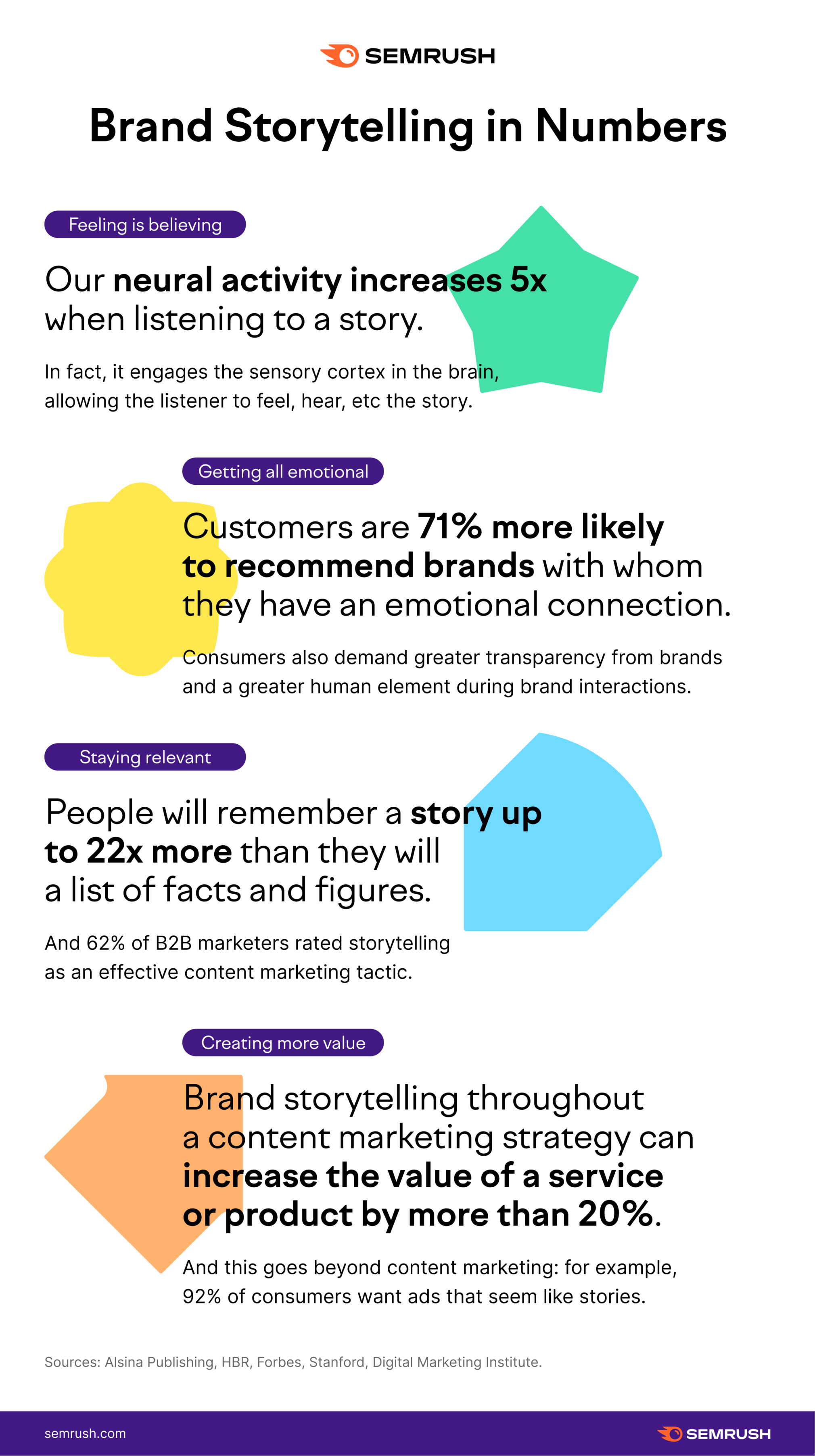
Brand storytelling is used to explain your values and engage customers who share those values. When you find customers who share your values, there’s a much greater chance that they will be loyal to your brand.
A Harvard Business Review study found that emotional connection is a significant driver of brand loyalty, and it is one of the best indicators of future customer value. Furthermore, customers are 71% more likely to recommend brands with whom they have an emotional connection.
Psychologist Jerome Bruner also discovered that when stories are used to communicate messages, people remember them 22x more than facts and figures alone. This is so important in today’s busy world, as we are constantly navigating distractions.
Skillful and strategic brand storytelling remains one of the most effective ways for businesses to capture people’s attention and deliver consistent marketing messaging.
Good stories surprise us. They make us think and feel. They stick in our minds and help us remember ideas and concepts in a way that a PowerPoint crammed with bar graphs never can.
Shane Snow, The Storytelling Edge
Examples of Brands with Strong Storytelling
Stories make our marketing campaigns and content more memorable. One great example of brand storytelling in a not-so-sexy industry is GEICO. The insurance company, which started out providing insurance products to employees of the federal government, is now the second-largest auto insurer and one of the largest homeowner insurers in the US.
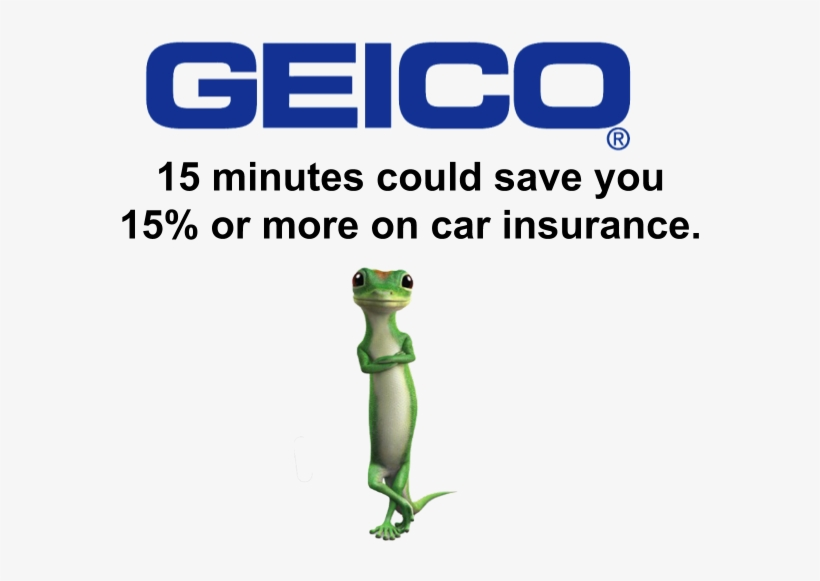
GEICO uses the power of storytelling to communicate value around a low-interest category in highly-engaging ways. Anyone who watches television in the US has heard the famous GEICO tagline, “15 minutes can save you 15% or more on car insurance.”
This short, catchy phrase, coupled with various entertaining spokes-characters like the GEICO gecko, creates a narrative that the company values fun, simplicity, and affordability. Using storytelling, GEICO encourages consumers to have a light-hearted attitude towards purchasing a traditionally “boring” product and helps them see the value of paying less for it.

Another example of a brand that changed the way people feel about a “boring” task is Mailchimp. The company managed to make email marketing software fun by building a quirky and fun brand for its users to rally around.
When the company launched, it used a cartoon monkey mascot, Freddy, and informal product copy to stand out amongst existing email marketing solutions and appeal to its target audience: small businesses.
Mailchimp has always put its brand story front and center. In 2019, the company announced its new all-in-one Marketing Platform on its blog. But rather than detailing the new product and its features, they used this opportunity to retell their brand story.
Authored by the CEO, Mailchimp used this piece of content to create empathy with its small business audience. They showed images of their own family and discussed how the launch was just one more step towards achieving its mission of helping small businesses succeed. There were no technical, pricing, or product details in the blog post. Instead, the short story focused on a character arc, showing how the founders' personal experiences led them to help others who are "just like them."
 Source: Mailchimp
Source: MailchimpOf course, creating your brand story from scratch can seem like a daunting process. That’s why we’ve put together this complete step-by-step guide to help you understand the elements of powerful brand storytelling and how to map out your own brand story with success.
The Elements of Powerful Brand Storytelling
Now that we’ve covered what brand storytelling is, why it matters, and how to identify your brand story, let’s list the rules for making your brand story effective and memorable.

Here are some of the key elements to produce a narrative that sticks:
Empathetic: Your audience should see themselves in your story. They should be able to put themselves in the place of the “main character,” and when the main character feels happy or sad, they should feel the same way. Attention-grabbing: Your brand should have a distinct voice and personality that is recognizable and stands out. Use this voice, language, and tone to grab your audience’s attention in your storytelling. Authentic: Success storytelling requires truthfulness. Be honest about your values, what makes your company unique, and even the challenges you face. We’ve all faced setbacks that have shaped us into who we are today, and brands are no different. Relatable: Remember you are speaking to real people. Try to avoid overusing industry-specific or technical jargon and show that you understand who they are and what challenges they face. Your storytelling should sound human! Consistent: Your audience should know what to expect from you while still looking forward to what’s next. You want them to come back again and again to find out how the character is doing and where the story is going. Aligned with Business Goals: Your brand story should be aligned with your business goals and integrated into all areas of your business — including marketing, sales, and all internal and external communications. Enhanced with User-Generated Content: When possible, allow your customers or users to help tell your brand story. User-generated content (UGC) is an honest opinion about your brand and is known to help boost purchasing confidence. Provokes Action: There must be a point in any story when your audience understands its meaning, and that’s when you introduce your call to action — or, in storytelling terms, an “inciting incident”.How to Map Out Your Brand Story in 6 Steps
Documenting your brand story is a key step in building a foundation for your marketing strategy. Once complete, you will be able to use your brand story as a compass for any content, communication, and marketing campaigns.
Grab our free Brand Storytelling Template and follow each step below to complete it successfully.
Step 1: Define your goals and the purpose of your brand story
To create a great brand story, think about what messages you want to convey with your story, how you want your audience to feel, and ultimately what you want them to do.
Your goals may be related to revenue growth, organic traffic, increasing followers, or raising brand awareness in general. List these goals and then list your existing resources that can help you reach them. For example, you may already have an innovative product or a vibrant online community you can leverage to achieve your goals.
Step 2: Think about your background
Take time to define your personal goals, values, and how certain events in your life brought you to today. This step will help you understand how your personal experiences may influence your company’s goals and mission. It is also a useful exercise to help you pinpoint specific personal experiences to use in your brand storytelling to create an emotional connection with your audience.
Think about the history of your company. Why was it created? Who is/are the founder(s), and what is the vision? How was it founded? What challenges did you face, and what successes did you have?
This is a good time to list interesting facts and details about your organization and its background.
When Sarah Paiji Yoo became a mom, she realized she was using a lot of single-use plastic. She was horrified to learn how plastic contaminates water supplies and that she might be giving her baby water and food that was filled with microplastics.
Unable to find household products that didn't come in plastic packaging, she created her own company, Blueland, to sell eco-friendly products in reusable packaging.
Sarah’s story is highlighted all over the Blueland website and social media. Her mission is the company's mission, and it is the foundation for all of their products.
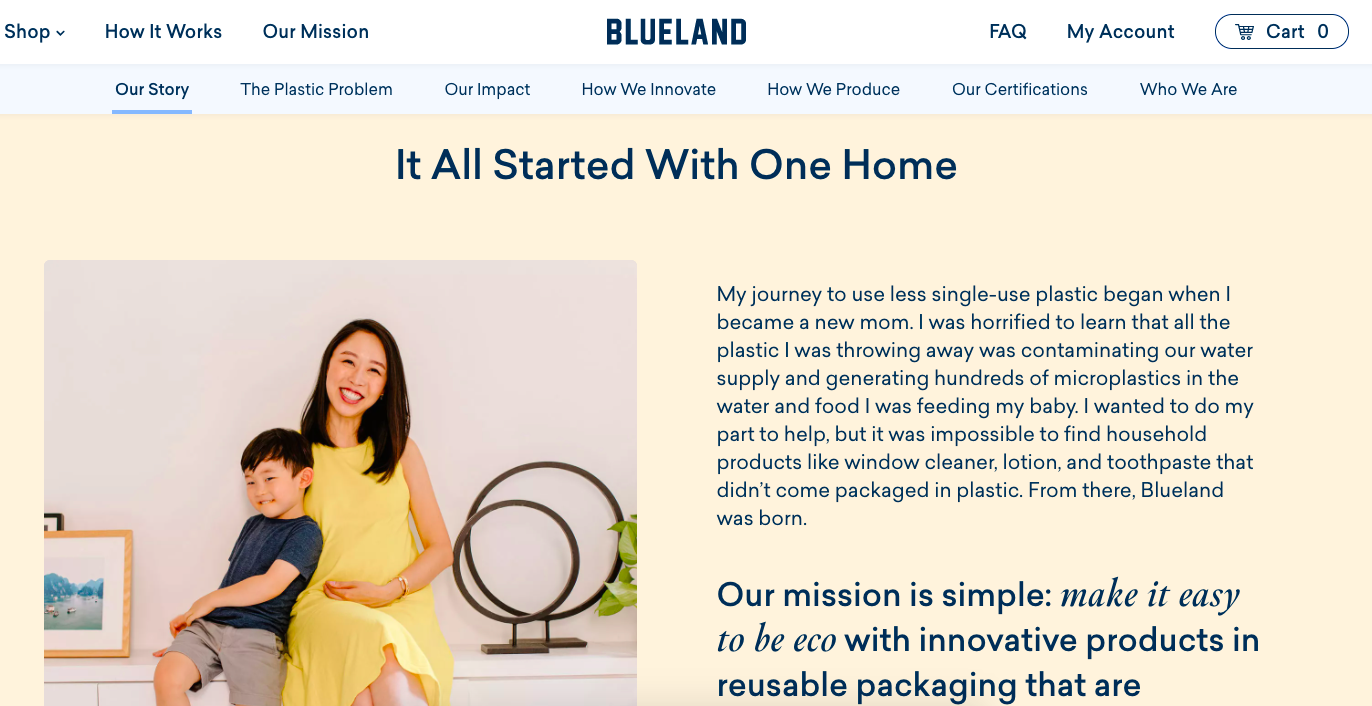 Source: Blueland
Source: BluelandHaving your buyer personas clearly defined will also help with the next steps in developing your brand story. If you’ve never created buyer personas, our Buyer Persona tool and free templates makes them effortless to put together.
Step 3: Map out your hero’s journey
There are many different structures, or “templates,” you can follow to tell your story, but one of the most popular is The Hero’s Journey. This storytelling structure was made famous by educator and widely-published author Joseph Campbell, and it is often used to structure science fiction, fantasy, and horror stories.

The Hero’s Journey is one of the most famous story structures because it gives the audience exactly what they want. First, the “hero” is called to adventure, then there is a conflict/action, and finally, a resolution or reward.
This storytelling structure follows an emotional arc that resonates extremely well with consumers in marketing materials. The hero (your customer) and behaviors are clearly defined, it explains how and why their status quo was disrupted, how your solution helped them tackle their problem, and what is the end result.
Start documenting your hero’s journey by answering the following questions:
Who is your hero (customer)? What are their needs and wants? What is their problem and how are they solving it now? How can your brand step in to help them and how would they hear about you? What is the solution you are offering? What does transformation and a better future look like?Now, you can put that information into the 8-act structure below — available in our free Brand Storytelling Template:
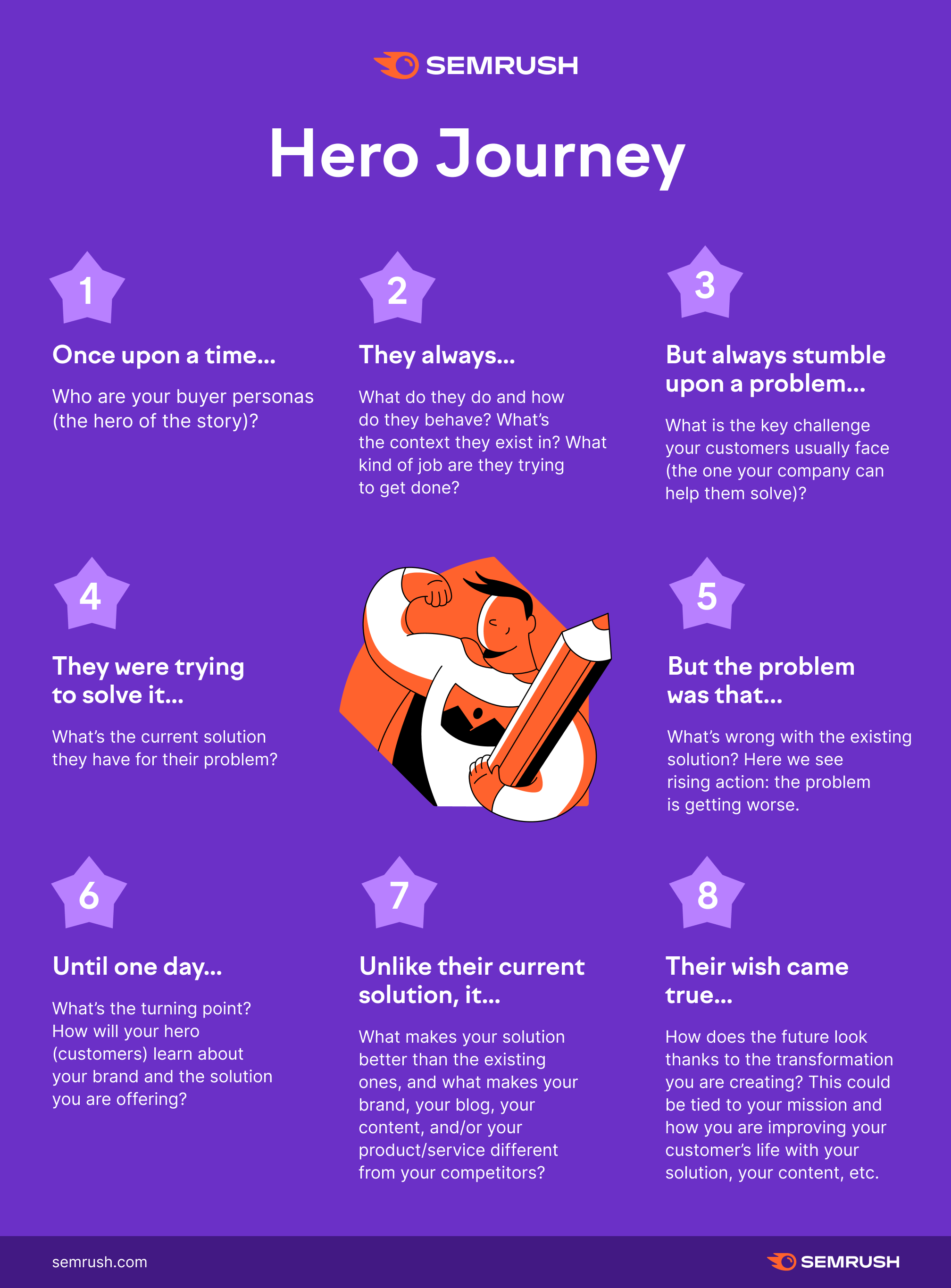
Step 4: Think about your brand personality
The next step is to identify your brand personality. Defining your brand personality involves applying human characteristics to your brand. Typically, it is based on the personality of your customers and their preferences. A well-defined personality will help you connect with your customers on a deeper level.
One of the approaches that can help you define your brand personality is the Brand Archetypes Framework.
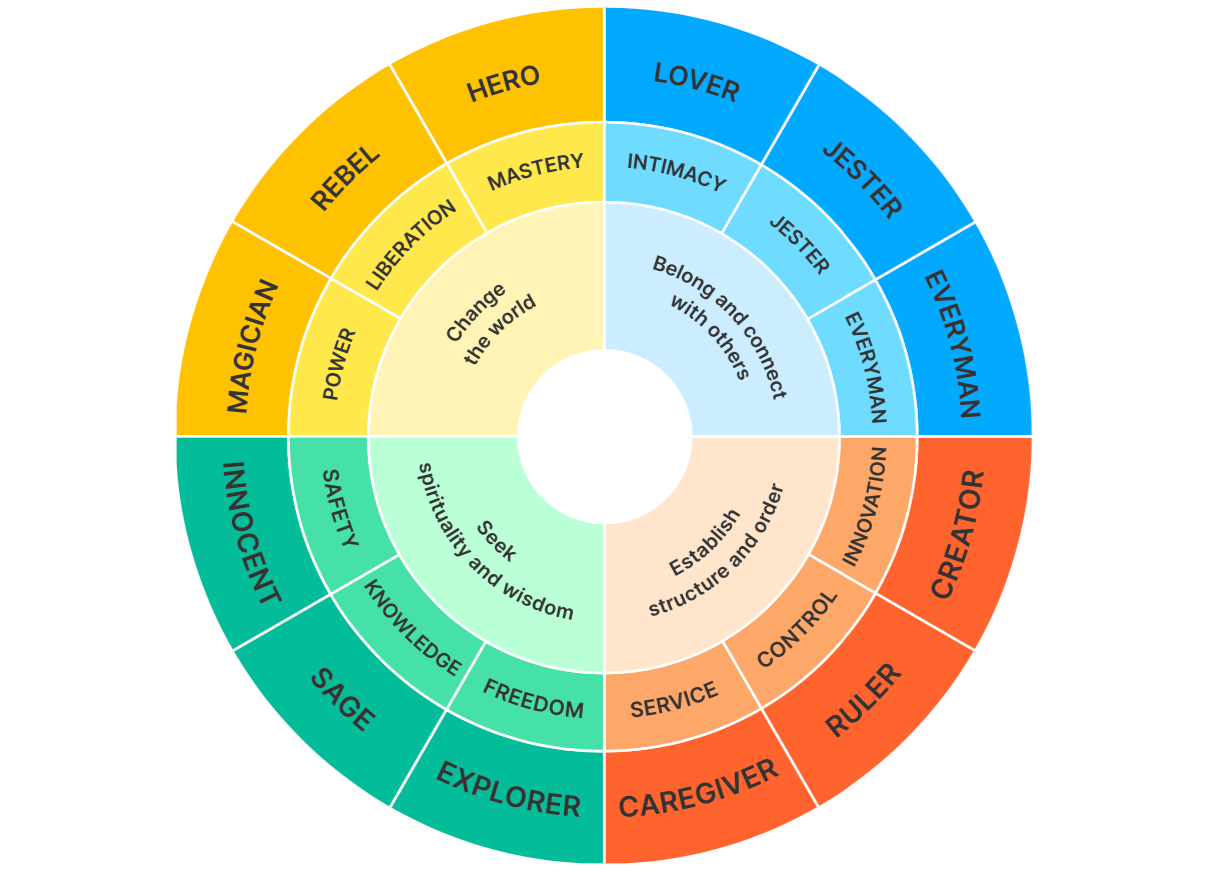
Brand archetypes represent the key personality types. First, you will want to identify your hero’s (customer’s) personality. A good way to do this is to think about how customers engage with you. Then, align your brand and its story with an archetype closest to what your customers are seeking.
Learn more about brand archetypes in this blog post.
Step 5: Define your brand purpose and values
In this step, you will want to define your brand purpose and values if you haven’t already. These elements will serve as your compass when crafting stories and help to make sure they highlight your brand’s greatest goals.
Brand Purpose
This is one sentence that communicates the value you create in the lives of your customers. It should be based on your brand story. For example, “my brand’s purpose is to change the way you…”.
Here are some examples from other brands:
Dove: To help women everywhere develop a positive relationship with the way they look, helping them realize their full potential. Patagonia: To build the best product, cause no unnecessary harm, and use business to protect nature. Intuit: To power prosperity around the world.Brand values
Identify 4-5 values that matter most to your company and specify why. Great brand values should set you apart from other brands. Try to keep them clear and concise.
Here are some examples:
Adidas: Performance, Passion, Integrity, Diversity Cars.com: Accessibility, Convenience, Risk Reduction, Brand/Status Zara: Beauty, Clarity, Functionality, Sustainability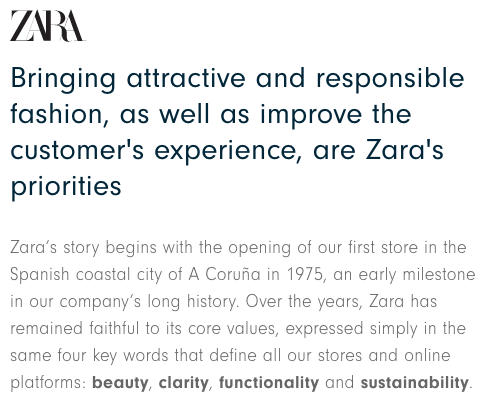 Source: Zara
Source: ZaraStep 6: Write down your brand story
Now you are ready to write a brand story that shows your real value to customers, outside of the solutions you provide. Make sure it answers key questions about your customers’ challenges and needs, why your brand exists, and your mission. Here’s a quick brand storytelling guide.
It should be around 200-300 words and cover:
What is the current context that your customer (hero) operates in? Think about their challenges and needs. What is the reason your brand exists, what is its mission: how are you trying to change your hero’s life? What does the future you envision for your brand look like? What is the one unique thing your company can deliver that no one else can?Brand Story Example
Another excellent example of a brand that has used its purpose to enhance its business storytelling and drive success is Oatly. The Swedish company, founded in 1994, spent 20 years as an undifferentiated oat milk producer until it repositioned the brand and started highlighting its brand story and purpose.
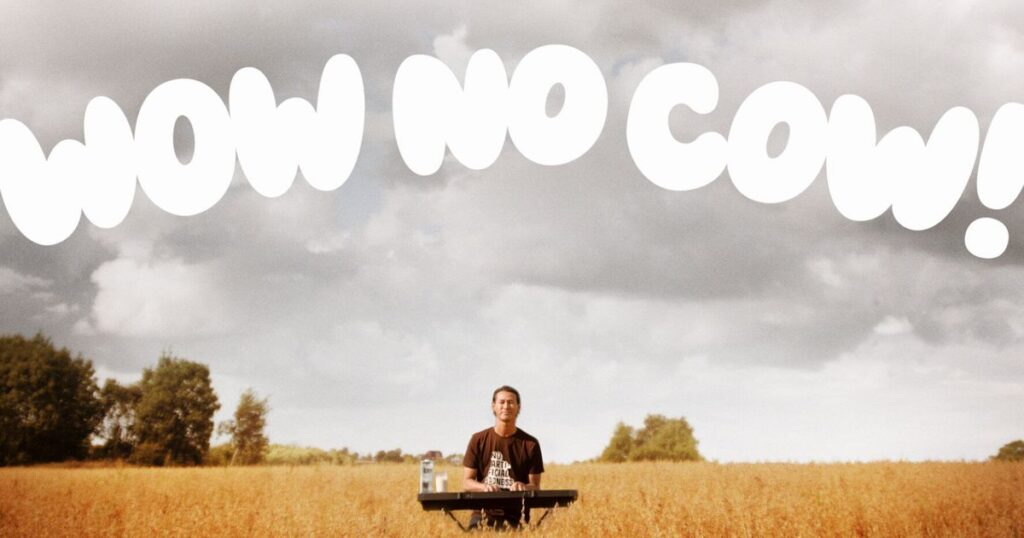
Oatly’s purpose is to replace cow’s milk and show that its products are “Made for Humans.” The company uses a lot of fun visuals to illustrate this purpose in its marketing campaigns. But they also rely heavily on storytelling.
From highlighting independent coffee shop owners with its Hey Barista Instagram account to sharing educational content about plant-based living, the brand successfully engages its target audience and creates community around its purpose without pushing its products. Today, oat milk is the second- largest dairy alternative following almond milk — showing how this brand storytelling example really made an impact.
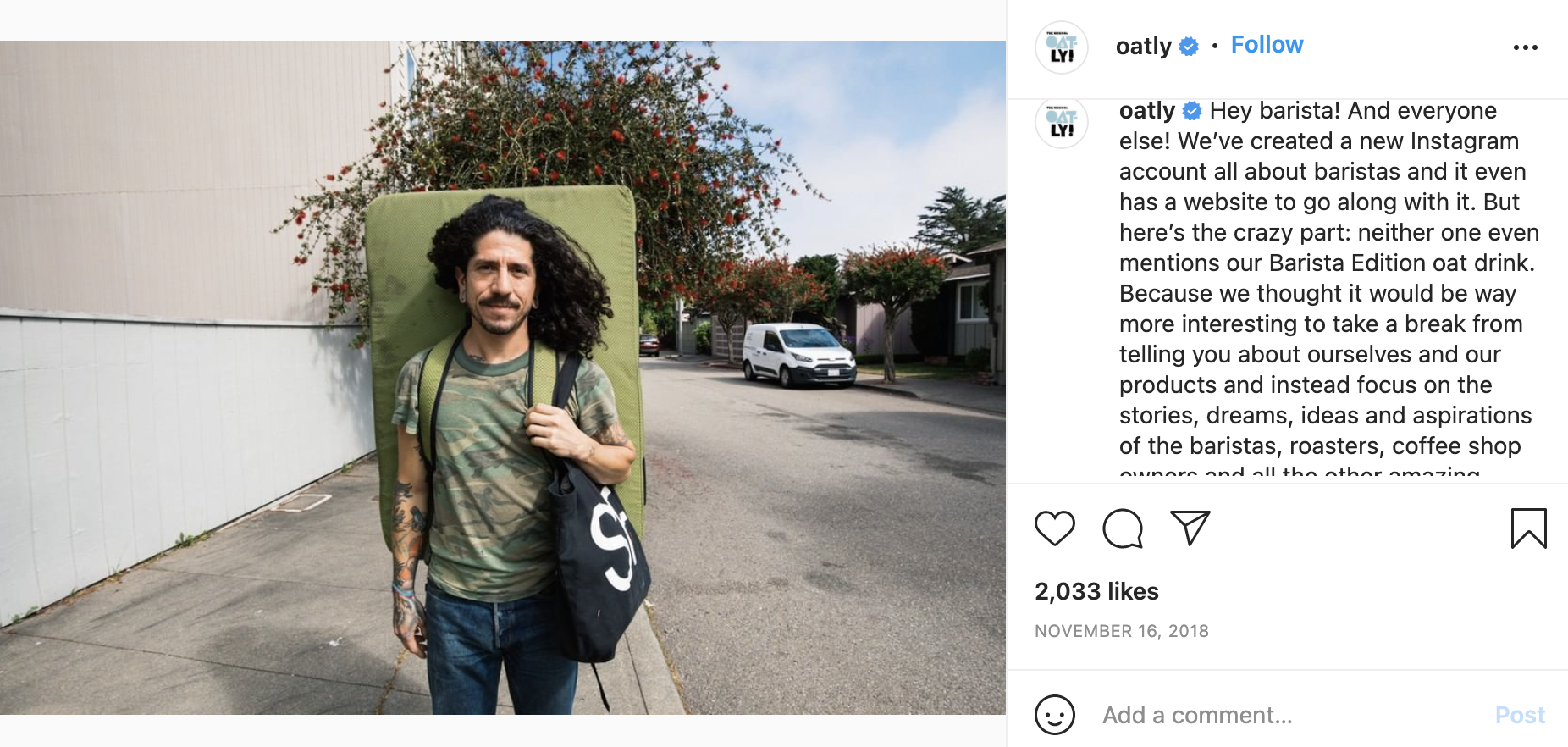 Source: Instagram
Source: InstagramShare and Grow Your Brand Story
Congrats! Now that you have your brand story documented, you’ll want to make sure other key elements of your storytelling strategy, such as your tone of voice, brand style guidelines, and writing style guidelines are ready to go. Check out our separate guide on how to define your brand’s tone of voice.
Finally, you should share your brand story across the entire company. Brand storytelling should serve as a compass for everything you do in your organization: from marketing and public relations campaigns to human resources and sales. To effectively share your brand story with every employee, it might be worth creating an explainer video that captures the essence of your brand.
It should also serve as the foundational document for your content strategy. You can use it as a starting point when creating content plans, producing content, and even when onboarding new writers and other content creators.
Most importantly, your brand story should be a “living document” and evolve with your company. You should also review it from time to time to make sure it reflects any feedback from your customers.
How to Use Your Brand Story in Content Marketing and SEO
The most successful brands around the world use different types of brand stories in their content marketing to reach their target audiences.
Storytelling is a key pillar of content marketing because it gives you the ability to draw in your audience with enticing narratives and keep them engaged for much longer than possible with just data and facts about your product or service.
One example of a brand that is a master at using storytelling in content marketing is Whole Foods. The multinational supermarket chain uses social media and its blog to share educational content, recipes, and helpful tips for parents without blatantly promoting its products.
Whole Foods’ story is about more than just food. It is about living a healthy lifestyle. The company uses storytelling to highlight its purpose (“to nourish people and the planet”) and its core values, which include serving and supporting a local experience and practicing environmental stewardship to motivate and engage its customers.

You can use our Topic Research Tool to find topics that align with your story and hero. Simply enter a topic that you want to create content around and receive tons of subtopics and ideas related to the topic. Use that information to help you figure out what will resonate with your audience.
Is there a difference between content marketing and storytelling?
While content marketing is a channel to share brand stories, it’s important to remember that not all content marketing is storytelling!
Content marketing is about creating and sharing educational or promotional content for your target audience to attract new customers, engage existing ones, and create brand loyalty. Content marketing is just one channel for telling your overall brand story, which is what people believe about your brand based on the messages you put out there. Storytelling tools and techniques are used to create branded content that speaks the values and vision of your company and generates an emotional response.
Storytelling’s Role in SEO and Link Building
Storytelling can also complement SEO strategies when it comes to getting your content noticed and ranked well by search engines. As per Dale Bertrand, Founder and President at Fire&Spark:
Instead of focusing your SEO efforts on guessing the technical signals that will curry favor with search engines, why not build a compelling, story-driven brand that resonates with online consumers and generates the signals Google is looking for as a side-effect? Brand storytelling naturally leads to content that generates engagement, E.A.T. and backlinks.
Dale Bertrand, Founder and President at Fire&Spark
The reality is that the definition of “high-quality content” and what actually works for link building is constantly changing. If you want to stand out and create a strong brand, then you need to tell stories that resonate with your audience, Bertrand explains.
He uses an example of a business that sells high-end 3D printers to manufacturing companies.
While the brand is focused on selling the reliability of the machines and stellar customer service, the brand stories they use for link building are more focused on the problems that amateur 3D printing “hobbyists” face.
These stories are not targeted at professional engineers because it’s far more lucrative to generate links from hobbyists as they are much more active online.
Brand stories can also be used in different ways to achieve different business goals.
“You must find issues that authentically align with your brand (you can't fake it) so you can connect with publishers on a human level,” Bertrand explains.
Next, develop various forms of content to tell your brand stories — issue-oriented articles, guides, interviews, case studies, etc.
Make sure your content is always aligned with your brand and opinionated.
Finally, promote your content to the publishers you identified in the first step. Your outreach emails should ask for help promoting an idea or cause that you both care deeply about.
This approach works much better than asking for a link to a piece of content. You'll still get links but that won't be your first ask.
Check out our recent webinar with Dale to learn more about purpose-driven content marketing and SEO.
Conclusion
Today, many consumers view what they purchase and the brands they support as an extension of their own identity and values. They seek to understand a brand’s purpose and mission, and they want to feel like they are a part of a community that shares their values.
This is why it is so important to define your story and reinforce it with every marketing message you share so that when people are ready to buy, your brand will be the first one that comes to mind.
Make sure that your brand story is intertwined in any content marketing you do. Whether it’s on your website, blog, or social media channels, stay true to the story, tone, and voice you defined in this process. When done right, using storytelling in content marketing is one of the best ways to differentiate your brand, create an emotional connection with your target audience, and ultimately convert them into lasting customers.
Innovative SEO services
SEO is a patience game; no secret there. We`ll work with you to develop a Search strategy focused on producing increased traffic rankings in as early as 3-months.
A proven Allinclusive. SEO services for measuring, executing, and optimizing for Search Engine success. We say what we do and do what we say.
Our company as Semrush Agency Partner has designed a search engine optimization service that is both ethical and result-driven. We use the latest tools, strategies, and trends to help you move up in the search engines for the right keywords to get noticed by the right audience.
Today, you can schedule a Discovery call with us about your company needs.
Source:





